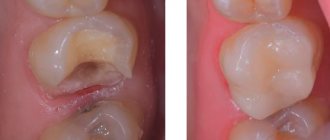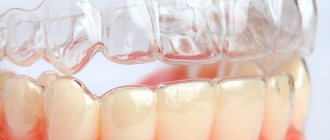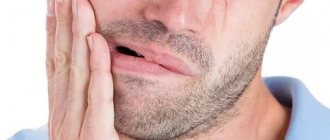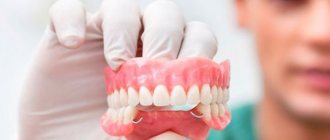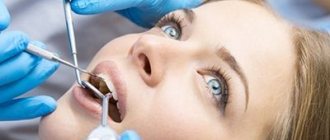What is therapeutic dentistry?
There are many different areas of dental practice. Therapeutic dentistry is a fundamental area whose objectives are to treat diseases of the teeth and periodontal tissues.
Services provided by therapeutic dentistry:
- treatment of dental caries and any of its complications (pulpitis, periodontitis);
- treatment of gum inflammation (gingivitis, periodontitis);
- treatment of non-carious enamel lesions (fluorosis, hypoplasia, erosion);
- treatment and restoration of teeth after injury;
- elimination of birth defects of shape or color.
The methods of modern therapeutic dentistry are aimed at preserving teeth and eliminating factors that can lead to its destruction.
IV. Responsibility
The dentist is responsible for:
1. For improper performance or failure to fulfill one’s job duties provided for in this job description - within the limits determined by the current labor legislation of the Russian Federation.
2. For offenses committed in the course of carrying out their activities - within the limits determined by the current administrative, criminal and civil legislation of the Russian Federation.
3. For causing material damage - within the limits determined by the current labor and civil legislation of the Russian Federation.
4. ____________________________________________________________________
This job description has been developed in accordance with the provisions (requirements) of the Labor Code of the Russian Federation dated December 30, 2001 No. 197 FZ (Labor Code of the Russian Federation) (with amendments and additions), the professional standard “Dentist” approved by order of the Ministry of Labor and Social Protection of the Russian Federation Federation dated May 10, 2016 No. 227n and other legal acts regulating labor relations.
What does a dental therapist do?
Within the competence of a dentist-therapist is the treatment of major dental diseases. A dental therapist does the following:
- conducts an initial consultation;
- performs an examination and, if necessary, refers the patient to hardware diagnostics (X-ray, orthopantomogram, CT);
- makes a diagnosis;
- draws up a treatment plan;
- provides treatment for caries and other dental diseases;
- performs fillings and direct restoration of teeth;
- carries out professional oral hygiene;
- eliminates cosmetic defects of teeth, carries out whitening procedures in dentistry;
- carries out other preventive procedures (remineralization, fluoridation, etc.)
As a rule, a dental therapist also specializes in endodontic treatment, and performs cleaning and root canal treatment.
Surgical dentistry, what is it?
Posted by Marbery Gedrean | Checked by: Shteba Victoria Petrovna | Last revised: April 21, 2022.
Surgical dentistry is one of the areas of dentistry that solves problems of the dental system through surgery. Dentist surgeons perform tooth extraction operations, incl. wisdom teeth, cysts, tooth-preserving operations, soft tissue operations - plastic surgery.
Dental surgeons are involved in the diagnosis and treatment of pathological conditions of the teeth, jaws, sinuses, temporomandibular joints, soft tissues, and oral mucosa.
Why do I need dental surgery?
Here are some conditions that require a dental surgeon:
- The tooth is injured (impossible to restore) or broken;
- Severely damaged tooth (impossible to restore);
- Ineffective conservative dental treatment when remission and recovery do not occur;
- If classical root canal treatment is not possible;
- There is a cyst on the root of the tooth that is prone to growth;
- There is a cyst in the jaw from a tooth germ that grows and increases the risk of jaw fracture;
- If the frenulum of the tongue or lip is short;
- An inflammatory process that requires immediate intervention.
Tooth extraction
This is a major surgical procedure, so it is important to know that after tooth extraction there is an individual healing period when you must follow your dentist's recommendations.
Common reasons for tooth extraction
- Severe destruction;
- A purulent growth around the root of a tooth (cyst);
- Fracture of a tooth or root;
- Serious tooth displacement;
- Orthodontic reasons (malocclusion);
- Progressive periodontal disease;
- Unerupted teeth.
About wisdom teeth
Surgical removal of wisdom teeth is one of the most common operations in dental surgery. Most people's wisdom teeth erupt during adulthood (18 to 25 years). In 80% of cases it is advisable to remove them.
Why remove wisdom teeth?
- The most common reasons here are lack of space, primarily in the lower jaw. With partially erupted wisdom teeth, acute infection often occurs. A pocket forms under the gum cover in which bacteria multiply. This infection often leads to severe pain, redness and swelling of the surrounding soft tissue, problems swallowing and even difficulty opening the mouth, as well as the formation of abscesses;
- Due to wisdom tooth displacement: lack of space in the jaw often results in an axial tilt of the tooth. Horizontally lying wisdom teeth can put pressure on neighboring tooth roots and cause inflammation of the pulp and surrounding tissues of this tooth. A vertically lying wisdom tooth can cause problems with sensitivity, as it can press on a nerve;
- Due to caries or pulpitis in the wisdom tooth, as it is often difficult to cure due to inability to access;
- In case of a fracture of the lower jaw, if the wisdom tooth is located in the fracture line;
- For orthodontic indications in case of malocclusion, when the wisdom tooth presses and displaces the dentition or space is needed for the teeth to move;
- For rational dental prosthetics.
Surgical extractions in the lower jaw are often associated with complications
It is important to keep in mind that the bone density in the lower jaw is more pronounced than in the upper jaw. Therefore, surgical removal in the lower jaw is often associated with complications. The wisdom tooth has many variations, both in its anatomical shape and in the number of roots. Therefore, extracting wisdom teeth is usually a more difficult process.
Before surgery, the patient takes an anti-inflammatory drug and an antibiotic (as indicated), then a long-acting pain reliever is administered. The tooth is often fixed in the jaw due to ankylosis (attachment to bone tissue). If access to other chewing teeth is limited and the angle of the jaw is too small, or if the tooth lies horizontally in the jaw, the tooth must be divided.
After wisdom tooth removal surgery
Oral hygiene can proceed as usual. If severe pain occurs, brushing should be temporarily avoided and a medicated mouth rinse (0.1% chlorhexidine) may be used instead. Avoid excessive nose puffing and sneezing, especially after removal of upper wisdom teeth.
Should be limited:
- Coffee, black tea, energy drinks;
- Alcohol, cigarettes;
- Sports, sauna, solarium, sun exposure;
- Hot food and drinks.
Typically, wound healing occurs quickly and the procedure is performed without complications. After 3 weeks, the oral mucosa is completely healed.
Root treatment
Root treatment is necessary if the tooth pulp is infected with bacteria or has already become necrotic. The dental pulp is a connective tissue with a nerve, arteriole and venule. If the root canal is thoroughly cleaned of dead pulp, thoroughly disinfected, sterilized with special means and tightly obturated (sealed), then such a tooth will serve its owner for the rest of his life.
The most common causes of dental pulp damage are:
- Caries;
- Injury;
- Periodontitis (deep pockets);
- Open neck of the tooth;
- Severe teeth clenching or grinding;
- Irrational orthodontic treatment.
Infected tissues inside the root swell and expand due to bacterial growth and an inflammatory response, but they cannot do this in the root canal because it is surrounded by dense tooth structure. Thus, the infection spreads through the apical foramen in the roots, at the place where nerves and blood vessels penetrate from the bone tissue into the root of the tooth. If the infection reaches the jaw bone, we call it periapical disease. Pain in the tooth becomes pain in the entire jaw. Cleaning and sterilization of the root canals followed by filling and filling the canals is necessary to preserve the tooth and stop the pain.
Dental cysts
A cyst is a lesion around the tip of the root - the apex. Dental cysts can sometimes be removed surgically. They are especially common in patients with caries-affected teeth. The most common cause of dental cysts is non-viable pulp (nerve of the tooth) and poorly or insufficiently carefully processed and sealed root canals.
APOLLONIA Dental Clinic recommends that you undergo a preventive examination with a dentist at least 2 times a year to minimize the risk of caries and complications!
Modern methods of therapeutic treatment in dentistry
Therapeutic treatment in dentistry includes a whole range of procedures, including diagnostics, filling, and removal of dental plaque on the teeth. For any problem, modern dentistry has several solutions.
Diagnostics in therapeutic dentistry
When a simple visual examination of the oral cavity is not enough to accurately make a diagnosis, identify the source of inflammation, or assess the nature of the pathology, the dentist-therapist prescribes hardware dental diagnostics to the patient.
The following types of hardware diagnostics are used in therapeutic dentistry:
- targeted x-ray – pinpoint identification and confirmation of the problem, monitoring treatment results;
- orthopantomogram - a panoramic image, effective in studying difficult-to-diagnose cervical caries, with multiple caries, gives an idea of the condition of all teeth of both jaws;
- CT is a method that provides the most detailed display of the condition of the teeth, the structural features of the root canals, the condition of the periodontal tissues, bite, and helps to identify any pathologies of the dental system.
Dental treatment
The most common dental disease that a dentist has to deal with is caries. The cause of caries can be poor hygiene, internal diseases, mineral deficiency in the body and many other factors. The danger of caries is that up to a certain point it develops without obvious symptoms, and it can only be detected during a dental examination, where the doctor uses a special instrument.
Therapeutic dentistry today can offer patients the most effective methods of treating and preventing infection. Traditional treatment of caries is carried out in several stages:
- 1
Examination, pathology analysis, assessment of the size of the carious cavity, drawing up a treatment plan. - 2
According to indications (in case of hypersensitivity, deep cavity), the doctor applies local anesthesia.
- 3
Preparing the tooth, removing infected dentin, forming a cavity and preparing it for filling.
- 4
Filling (restoration).
- 5
Final processing of the restoration (giving an anatomically correct shape, occlusion control, polishing).
In case of complications (pulpitis), cleaning, sterilization, treatment and sealing of the root canals are also carried out.
In addition to traditional filling, there is also a method of non-invasive treatment of caries at the initial stage (when the infection has affected only the surface enamel layer of the tooth) - ICON. This method is absolutely painless, is successfully used in adult and pediatric dentistry, and allows treatment without damaging healthy tooth tissue.
Gum treatment
Treatment of gums in a therapeutic dentistry office is carried out with a slight development of the inflammatory process and involves the following measures:
- removal of dental plaque, professional oral hygiene;
- elimination of factors that create favorable conditions for the development of infection in gingival tissues - treatment of caries, replacement of old restorations;
- treatment of inflamed tissues with special antibacterial agents (applications, application of medicinal gels);
- prescribing a course of drug therapy;
- consultation on home oral hygiene, prevention of gingivitis.
In case of serious damage to the gums (development of periodontitis, formation of periodontal pockets, tooth mobility, etc.), treatment is carried out by specialists from other branches of dentistry - a periodontist, a dental surgeon.
Prevention
The main cause of dental and gum disease in patients is dental plaque and tartar. Therefore, one of the best methods for preventing caries and gingivitis is professional oral hygiene in dentistry.
If there is a high predisposition to the development of caries (weak enamel), before orthodontic treatment, as a preventative measure, the doctor may prescribe the patient enamel remineralization (nutrition with minerals, strengthening of hard tissues, protection from destruction by infection).
Teeth whitening
Professional whitening effectively removes unaesthetic pigments of yellow, gray, brown shades on teeth. Modern technologies make it possible to carry out whitening without pain, without the risk of damaging the enamel.
Who is a dental surgeon and what diseases does he treat?
Dental surgery is a separate branch of medicine, the purpose of which is not removal, as many believe, but the preservation of teeth in the oral cavity. A dental surgeon not only pulls out teeth, but also performs operations to preserve them, diagnoses diseases of the oral cavity and more. Must have the skills of a therapist, orthopedist, and he is also both a pediatric dentist and a plastic surgeon. These essential skills will be continually used in practice.
What does a dental surgeon do?
The main task is to preserve teeth using all currently available methods. He does this using operational methods. Provides the following services:
- prepares the oral cavity for installation of implants;
- removes benign and malignant tumors inside the mouth;
- carries out restorative maxillofacial manipulations;
- eliminates inflammation in the periodontium;
- deals with complex molar removal;
- corrects defects of the tongue and gums.
Pros - versatility, the ability to perform both complex and simple operations, cons - it is difficult to find a really good surgeon.
How is it different from a dental therapist?
The main differences are the methods of influence. The dentist-therapist performs artistic restoration of dental units using fillings (seals dental canals and crowns). He does not perform complex operations and does not remove complex teeth, unlike a dental surgeon. The therapist may have absolutely no understanding of prosthetics or bite correction, but this does not mean that he is worse, he just has a different specialization. These specialists should always work closely together to provide the best possible care to the patient.
The main difference between a dental surgeon and a therapist is the degree of radicality of the effect on the tissue.
What services does it provide and what diseases does it treat?
The list of services includes the following operations:
- plastic;
- cystectomy;
- resection of the apex of the tooth root;
- extraction of retained and dystopic eights;
- curettage;
- removal of tooth fragments;
- patchwork operations on the gums.
Operations are selected depending on the situation:
- When a patient loses teeth, he needs prosthetics and turns to an implantologist. If there is no such specialist in the clinic, the procedure is performed by a surgeon.
- The site is prepared and a titanium rod is installed in the bone, on which the artificial tooth will be attached.
- If you need to remove an unerupted figure eight, you cut the gum (and sometimes the bone), and then saw and take out the tooth piece by piece, using an extractor and a drill.
- If a cyst forms inside the jaw at the roots of the tooth, a cystectomy and resection of the apex of the tooth root is performed. These operations involve removing the cyst and part of the tooth root.
- Due to extensive periodontal disease or congenital anomalies, the patient may have gum defects associated with their structure. Such defects are corrected by an adult or pediatric dentist-surgeon using plastic surgery. It also restores the proportions of the jaw, which may be disrupted due to injury or congenital defects.
- In the treatment of periodontitis, thinning gums, and destruction of the jaw bone, the dentist performs flap surgery. Such an intervention involves excision and application of small flaps to areas of the mucous membranes where there is not enough tissue.
- In case of localized inflammation in the gum, when the cheek swells and everything hurts greatly, if the inflammation is caused by incomplete eruption of the wisdom tooth, the gingival hood above the tooth crown is opened, due to which the inflammatory process stops.
- If you need to clean periodontal pockets, remove stone from under the gums, deliver antiseptic medications to a hard-to-reach area, or stop alveolitis, curettage is performed. This surgical operation avoids extensive excision of the gums. Cavities in the gums are cleaned out with a curette.
Is it possible to call a surgeon at home?
Such a service exists, but few people know about it, since previously it was only available to patients with disabilities (disabled, elderly, mentally ill). Nowadays, many private clinics offer the service of calling a dentist at home. Every person who does not have the opportunity to go to the dentist because of work or fear can use the convenient service of calling a doctor at home and the doctor on duty will come to him.
It should be borne in mind that at home he can only carry out simple procedures, for example, diagnostics, pain relief, gum incision or teeth cleaning.
Complex operations require the use of special equipment that cannot be made mobile.
Does it heal or just pull teeth?
A specialist in the field of dental surgery also treats many oral diseases:
- abscess and cysts;
- alveolitis;
- ankylosis and arthritis of the temporomandibular region;
- dislocations and injuries of the jaw;
- gingivitis;
- dental hyperesthesia;
- bite deformities;
- infectious endocarditis;
- osteomyelitis;
- periodontitis and periodontal disease;
- pericoronaritis and pulpitis;
- stomatitis;
- sepsis, phlegmon, gumboil.
How long does the appointment last?
Depends on the problem with the teeth and its neglect. The appointment can last from 15 minutes if it is an examination or simple procedures, and up to several hours if it is complex operations. The duration of most operations is 40-60 minutes.
What else is included in the job description
If the qualifications of a dental surgeon allow, he can treat pathologies not related to teeth:
- inflammation of the facial nerve;
- inflammation of the lower jaw joint;
- dysfunction of the salivary glands.
Also, the dental surgeon examines and diagnoses diseases that are not related to the mouth, but give symptoms in a given place, such as syphilis and tuberculosis.
Cosmetic surgeries
In addition to basic dental operations, she performs plastic surgery:
- correction of the contour of the gum edge (gingivoplasty);
- expansion of the oral cavity (vestibuloplasty);
- trimming the lingual frenulum (frenuloplasty);
- elimination of recession (decrease in height) of the gums.
These operations improve periodontal tissue, correct speech therapy disorders and malocclusion deformities, and simplify further prosthetics. Also, a dental surgeon can correct aesthetic defects in appearance, namely congenital deformities: cleft palate, lips, defects of the ears and jaw.
Children's dentistry
Almost all of the listed services and functions may be required not only by adults, but also by children. A pediatric dental surgeon must undergo additional training, since working with children differs in many ways from working with adults. Must be able to correctly calculate anesthesia (so that a large dose does not hurt or cause harm) and perform operations quickly while the minimum dose of anesthesia is in effect. At this time, you need to talk to the child, calm him down and distract him.
Why does a surgeon need a certificate?
Every dentist needs this document, as it confirms their qualifications and level of professionalism. He has the right to treat people. The certificate is a mandatory document along with a diploma to work in the medical field. It is also desirable to have a certificate indicating the qualification category. There are two types of certificates:
- for compliance with ISO-9000 standards (these are international standards);
- StAR (Dental Association of Russia).
By studying the certificates, the patient can choose the best doctor and clinic.
Principles of therapeutic dental treatment at the Amel Dental clinic
- safety of all procedures;
- treatment without pain and without complications;
- desire to preserve teeth;
- the use of the most gentle treatment methods to minimize intervention and prolong the life of teeth;
- caring for the health and beauty of your smile.
Innovative technologies (modern stoma equipment, dental microscope), dental materials and medications of the highest quality help us guarantee such treatment results. We use digital technologies in diagnostics and treatment, which allows our doctors to make an accurate diagnosis, control all processes, avoid errors and guarantee patients high quality dental services.
III. Rights
A dentist has the right:
1. Request and receive the necessary information, as well as materials and documents related to issues of their activities.
2. Improve your qualifications, undergo retraining (retraining)
3. Take part in the discussion of issues included in his functional responsibilities.
4. Make suggestions and comments on how to improve activities in the assigned area of work.
5. Require the management of the organization to provide assistance, including ensuring organizational and technical conditions and execution of the established documents necessary for the performance of official duties.
6. Make independent decisions, guided by qualification requirements and job responsibilities
7.___________________________________________________________
FAQ
What is therapeutic dentistry?
This is a branch of dentistry that deals with the study, diagnosis, treatment and prevention of diseases of the teeth, tissues surrounding the tooth, and the oral mucosa.
Which doctor treats caries?
The dentist-therapist deals with the treatment of caries, as well as the treatment of non-carious lesions of teeth.
What does a dental therapist treat?
A dentist treats caries, gingivitis, non-carious damage to teeth, fills teeth, restores teeth after injury (chips, fractures), corrects cosmetic defects using direct restoration, treats diseases of the gums and mucous membranes, gives recommendations on the prevention of dental diseases and proper hygiene.
Problems solved by a therapist in dentistry
The most common reason for visiting this dentist is toothache of varying intensity. In addition, the following symptoms become a reason to contact a dentist-therapist:
- Gums bleed when brushing teeth and chewing food;
- the enamel has changed color;
C - white, yellow, brown, black spots appeared on the enamel;
- a piece of the tooth crown broke off;
- cracks have formed on the surface of the segments;
- the filling fell out of the cavity;
- a painful reaction to cold (hot), sour (sweet) food appeared;
- bad breath;
- swollen gums;
- other oral problems.
You should visit your dentist twice a year for a preventive examination, even if you have no pathological symptoms. This will help to promptly identify the disease at the beginning of the process, which will simplify its treatment and increase the chance of successfully getting rid of the problem.
